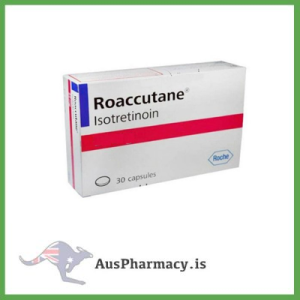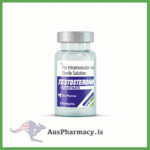Introduction
Isotretinoin, widely recognized under the brand name Roaccutane, is one of the most well-known medications in dermatology for managing severe acne conditions. While often discussed in medical and educational settings, its significance extends far beyond cosmetic value. It represents a key milestone in the scientific understanding of skin health, sebaceous gland function, and the molecular control of acne formation.
In this educational overview, we explore the composition, mechanism, and impact of Isotretinoin (Roaccutane) Capsules, focusing on their educational use in understanding dermatological pharmacology, patient care, and the importance of medical supervision.
1. What Is Isotretinoin (Roaccutane)?
Isotretinoin is a retinoid, a derivative of Vitamin A, and belongs to a class of compounds that influence skin cell growth and regeneration. Developed originally as a treatment for severe nodular or cystic acne, it is used under strict medical oversight due to its potent systemic effects.
From an educational standpoint, Isotretinoin serves as a key example of how vitamin derivatives can be repurposed for clinical use — transforming how dermatologists treat chronic skin conditions unresponsive to conventional therapies.
2. Composition and Formulation
Each Roaccutane capsule typically contains:
-
Isotretinoin as the active ingredient
-
Excipients such as refined soybean oil, hydrogenated vegetable oil, gelatin, glycerol, and coloring agents (depending on capsule strength)
Educationally, these components illustrate pharmaceutical formulation techniques that ensure drug stability and controlled absorption in the digestive tract.
Students of pharmacology and pharmacy often study how isotretinoin’s lipid solubility affects its absorption and how the presence of fats in the diet enhances bioavailability.
3. Mechanism of Action
Understanding how Isotretinoin works offers an excellent opportunity for students to explore biochemical pathways in dermatology:
-
Sebum reduction: Isotretinoin drastically decreases sebum (oil) production by shrinking sebaceous glands.
-
Keratinization control: It normalizes the shedding of skin cells, preventing pore blockage.
-
Anti-inflammatory effect: Reduces inflammation in acne lesions.
-
Bacterial control: Indirectly limits the growth of Cutibacterium acnes, the bacteria associated with acne formation.
This combination of effects makes isotretinoin unique — targeting acne from multiple biological angles rather than treating surface symptoms alone.
4. Educational Value in Dermatology Studies
In medical and pharmaceutical education, Isotretinoin is often studied for its:
-
Pharmacokinetics and metabolism
-
Dermatological application
-
Risk management programs
-
Patient education requirements
Students learn how isotretinoin functions as a systemic retinoid, exploring how vitamin A analogs influence gene expression related to skin cell differentiation and immune response.
It’s also used as a case study in courses related to clinical pharmacology, endocrinology, and toxicology, due to its wide-ranging physiological impact.
5. Indications and Educational Context
Roaccutane is used in clinical settings under prescription for severe acne that doesn’t respond to antibiotics or topical treatments. In educational environments, it helps illustrate:
-
The relationship between hormones, sebum production, and acne
-
How systemic medications can modify glandular and cellular activity
-
The importance of balancing therapeutic benefits with potential risks
Students studying dermatology learn how isotretinoin highlights the link between dermatology and endocrinology, where internal hormonal and metabolic factors influence skin appearance.
6. Importance of Medical Supervision
One of the most crucial educational lessons from isotretinoin use is the necessity of responsible medical oversight.
Due to its strong physiological effects, isotretinoin requires:
-
Regular medical monitoring
-
Liver function and lipid level tests
-
Strict pregnancy prevention programs
These aspects make isotretinoin a model case in pharmacovigilance education, teaching students how high-impact drugs are managed in clinical practice to ensure patient safety.
7. Dosage and Duration (Educational Reference)
Typical isotretinoin treatments last between 4 to 6 months, depending on the severity of acne. Educational examples often demonstrate:
-
How cumulative dosing works
-
The importance of individualizing dosage
-
How long-term remission can be achieved through cellular regulation
This helps students understand personalized medicine principles, where treatments are adjusted to individual metabolic and health profiles.
8. Commonly Discussed Side Effects
In academic discussions, side effects are analyzed to teach drug safety and patient communication. Common side effects include:
-
Dry skin and lips
-
Increased skin sensitivity
-
Temporary acne flare-ups
-
Changes in blood lipids
-
Fatigue or headaches
By understanding these effects, students learn how pharmacological potency requires balanced therapeutic planning and clear patient education.
9. Psychological and Social Dimensions
Another educational aspect is the psychosocial impact of acne and isotretinoin treatment. Acne can significantly affect self-esteem and mental health. Educators emphasize how dermatology isn’t only about visible symptoms — it’s about improving a patient’s quality of life.
Learning how isotretinoin has transformed the emotional and psychological outcomes of acne patients helps future healthcare professionals approach treatment holistically.
10. The Science of Retinoids
Retinoids, including isotretinoin, play vital roles in cell growth and differentiation. Students studying biochemistry or pharmacology explore how retinoic acid receptors (RAR and RXR) regulate gene expression.
This knowledge forms the foundation for developing newer dermatological therapies and understanding how vitamin A metabolism contributes to skin repair and regeneration.
11. Educational Case Study Applications
Universities and healthcare training institutions often use isotretinoin as a case study in:
-
Clinical pharmacology
-
Dermatology training
-
Ethical prescribing practices
-
Drug regulation and monitoring systems
It’s a powerful educational example of balancing drug efficacy and safety — showing students how proper monitoring can transform complex medical challenges into successful treatment outcomes.
12. Storage and Handling (Pharmaceutical Education)
In educational laboratories or pharmacy courses:
-
Isotretinoin capsules are stored below 25°C.
-
They are kept in dry, light-protected containers.
-
Safe handling procedures are followed due to their photosensitivity.
This reinforces lessons in pharmaceutical storage protocols and drug stability education.
13. The Role of Patient Education
Students also learn that patient understanding is critical. Even the most effective medication can fail without proper patient compliance.
Educational takeaways include:
-
Teaching patients to follow dosage instructions carefully
-
Explaining potential side effects clearly
-
Monitoring emotional well-being during treatment
-
Promoting open communication with healthcare professionals
Conclusion
The Isotretinoin (Roaccutane) Capsule stands as one of the most significant educational examples in dermatology and pharmacology. It demonstrates the intersection of science, safety, and human care — showing how advanced chemistry and biology can come together to improve lives.
For educators, students, and healthcare professionals, studying isotretinoin means exploring not just a drug, but a framework of responsibility, innovation, and ongoing learning in medical science.
Through careful education and understanding, future professionals can ensure that such powerful treatments continue to be used safely, ethically, and effectively in improving skin health worldwide.





